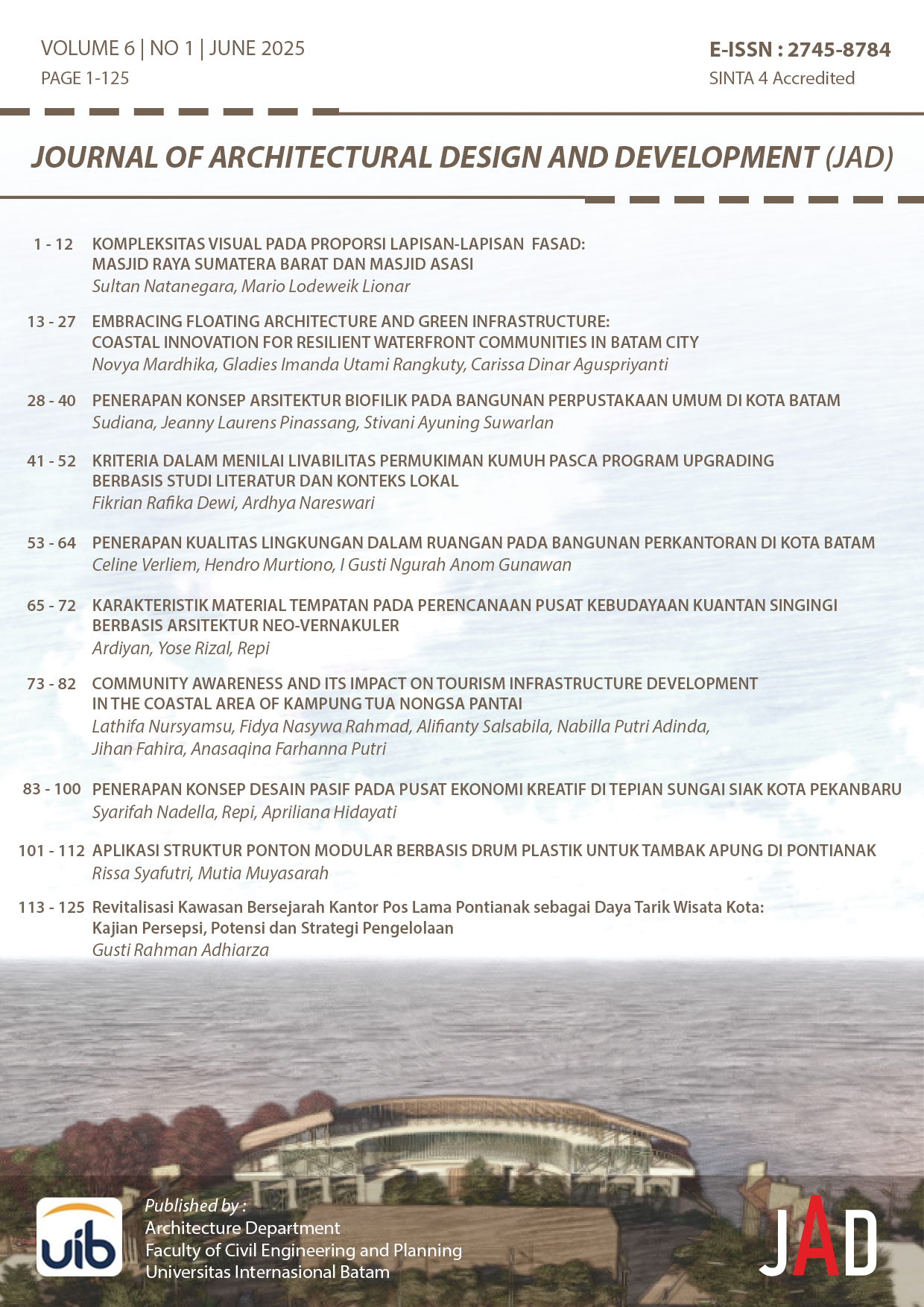Embracing Floating Architecture and Green Infrastructure: Coastal Innovation for Resilient Waterfront Communities in Batam City.
DOI:
https://doi.org/10.37253/jad.v6i1.9597Keywords:
Floating Architecture, Limited Land, Coastal Development, SustainableAbstract
In response to the pressing issues of environmental degradation due to uncontrolled urbanization, leading to alarming greenhouse gas emissions as well as the consequential rise in sea levels that is caused by the extensive loss of ice, this article explores the solution to coastal areas that are prone to flood which require a re-evaluation to accommodate growing populations. The article proposes floating architecture as the solution to this issue. Floating architecture seamlessly unites with the water bodies. This paradigm shift aims to tackle limited land availability, urbanization pressure, and rising sea levels by adapting to water levels. Floating architecture allows the ability for cities to expand to the waters when the land is scarce. Floating architecture also serves as attractions creating unique experiences and enhancing the communities surrounding. This study uses qualitative methodology followed by a descriptive approach to analyze completed and prospective projects to obtain insight into floating structure and design considerations. Results show that integrating sustainable design with floating architecture is much more cost-effective, sustainable, efficient, mobility, and flexible than land reclamation.
Downloads
References
Brundtland, G. H. (1985). World commission on environment and development. Environmental Policy and Law, 14(1), 26–30.
De Graaf, R. E. (2009). Innovations in urban water management to reduce the vulnerability of cities Feasibility, case studies and governance.
Endangsih, T., & Ikaputra. (2020). Floating Houses Technology as Alternative Living on The Water. IOP Conference Series: Materials Science and Engineering, 797(1), 012020. https://doi.org/10.1088/1757-899X/797/1/012020
IJzerman, M. (2021, January 21). Floating Office Rotterdam (FOR) — A Vessel for Change.
Youtube. https://www.youtube.com/watch?v=wYmu9sphOBU
Jefridin, H. (2023). Paparan Sekda Percepatan Penyusunan RDTR Kota Batam. https://www.scribd.com/document/644979989/PAPARAN-SEKDA-PERCEPATAN- PENYUSUNAN-RDTR-KOTA-BATAM-1-pdf
Kizilova, S. (2019). Form and functional features of modular floating structures. E3S Web of Conferences, 91, 05013. https://doi.org/10.1051/e3sconf/20199105013
Koekoek, M. J. (2010). Connecting modular floating structures: a general survey and structural design of a modular floating pavilion.
Murti, N. K., Suprapti, A., & Sardjono, A. B. (2020). Tipologi Bangunan Di Permukiman Bantaran Sungai Berdasarkan Lokasi Dan Jenis Konstruksi (Studi Kasus: Permukiman Bantaran Sungai Kahayan, Palangkaraya). Langkau Betang: Jurnal Arsitektur, 7(1), 14– 24. https://dx.doi.org/10.26418/lantang.v7i1.37646
Nguyen, T. T. T. (2021). Promoting sustainability and resilience in Vietnam’s floating community: the assessment of innovative housing units and materials for adaptation to climate change. https://opus4.kobv.de/opus4-btu/frontdoor/index/index/docId/5455
Perry, C. (2015). The neighborhood unit. In The city reader (pp. 607–619). Routledge.
Piatek, L. (2016). Displacing architecture? From floating houses to ocean habitats: Expanding the building typology. Education for Research, Research for Creativity. Ed. J. Słyk, L. Bezerra. Warsaw. Wydział Architektury Politechniki Warszawskiej, 273–280. https://floatingsolutions.org/wp-content/uploads/2019/12/Displacing-Architecture-Lukasz- Piatek-.pdf
Pinassang, J. L., Nursyamsu, L., & Murtiono, H. (2024). KONSEP GREEN SCHOOL DENGAN PENDEKATAN ARSITEKTUR EKOLOGI. Journal of Architectural Design and Development (JAD), 5(2), 136-149. https://doi.org/10.37253/jad.v5i2.9079
Rangkuty, G. I. U., & Nursyamsu, L. (2024). PESISIR YANG BERKELANJUTAN: GREEN ARCHITECTURE DENGAN BUDAYA POPULAR DALAM EXHIBITION DAN CONVENTION CENTER DI KOTA BATAM. Journal of Architectural Design and Development (JAD), 5(1), 64-73. https://doi.org/10.37253/jad.v5i1.9077
Rehman, S. (2020). FLOATING ARCHITECTURE. JAMIA MILLIA ISLAMIA NEW DELHI.
Slater, T., Lawrence, I. R., Otosaka, I. N., Shepherd, A., Gourmelen, N., Jakob, L., Tepes, P., Gilbert, L., & Nienow, P. (2021). Earth’s ice imbalance. The Cryosphere, 15(1), 233–246. Stopp, H., & Strangfeld, P. (2021). Floating Architecture 3: Construction on
and near water. Lit
Verlag. https://books.google.co.id/books?id=7cxLEAAAQBAJ
Sugiyono. (2017). Metode Penelitian Kuantitatif, Kualitatif, dan R&D. ALFABETA. https://elibrary.bsi.ac.id/readbook/206060/metode-penelitian-kuantitatif-kualitatif-dan-r- d.html
Wang, C. M., & Tay, Z. Y. (2011). Very Large Floating Structures: Applications, Research and Development. Procedia Engineering, 14, 62–72. https://doi.org/https://doi.org/10.1016/j.proeng.2011.07.007
Wang, C. M., & Wang, B. T. (2014). Great ideas float to the top. In Large floating structures: technological advances (pp. 1–36). Springer.
Wang, C. M., & Wang, B. T. (2015). Large floating structures. Ocean Engineering & Oceanography, 3. https://doi.org/10.1007/978-981-287-137-4







